云南省大学生在校期间备考ACCA有什么优势?
发布时间:2020-01-10
很多小伙伴都会纠结,大学期间既要完成学业,又要考研,还要准备毕业论文,这么多的事还要准备ACCA??那不是得不偿失吗?其实,学习ACCA的相关知识对我们的大学生活可谓百利而无一害的,并且相比较于你工作几年之后再来备考ACCA,在校期间备考51题库考试学习网认为更为妥帖一些,为什么这样说呢?且随51题库考试学习网一起了解一下,在校备考ACCA有何优势所在:
(一)高薪岗位:ACCA本科毕业生非常容易进入四大国际注册会计师事务所!如果在大学期间考过ACCA证书,证明你的确是一个十分有能力的人,让企业更加的认可你,你也会得到各式各样的工作机会和接触更多层面的人。
(二)三重保障:本校学历+国外文凭+ACCA证书,学员通过ACCA前两个阶段的考试后,在国内即可申请英国牛津布鲁克斯大学的应用会计理学士学位,如果你有意愿继续深造,还可以申请攻读伦敦大学专业会计硕士学位。
(三)技能教育:ACCA的课程就是根据现时商务社会对财会人员的实际要求进行开发、设计的,特别注意培养学员的分析能力和在复杂条件下的决策、判断能力。系统的、高质量的培训给予学员真才实学,学员学成后能适应各种环境,并逐步成为具有全面管理素质的高级财务管理专家。
(四)学习时间:相比较在职人员而言在校大学生有充足的时间来学习,没有工作上的琐事打扰,并且还有一个更加优良的学习氛围(校园),且因为大学生生活不像社会,有许许多多的诱惑和安逸考验着ACCAer们。
(五)学习能力:大学期间,正处于青春年少时刻,学习能力和精力是处于人生的旺期,相比较于在职人员,学习能力和效率高的不是一点半点。
学习和考试时间该怎样分配?
一、大一同学的ACCA规划:
NOW:提升自我财务英语水平
大一下学期:学习F1F2F3
大二上学期:学习F4F5F6
大二下学期:学习F7F8F9
大三上学期:申请牛津布鲁克斯学士学位及高级商业会计证书,并继续学习ACCA最后5门课程,或凭借ACCA成绩实习就业。
二、大二同学的ACCA规划:
NOW:提升自我财务英语水平
大二上学期:学习F1F2F3
大二下学期:学习F4F5F6
大三上学期:学习F7F8F9
大三下学期:申请牛津布鲁克斯学士学位及高级商业会计证书,并继续学习ACCA最后5门课程,或凭借ACCA成绩实习就业。
最后,51题库考试学习网想对大家说:“物不经锻炼,终难成器;人不得切琢,终不成人。”各位ACCAer们,加油~
下面小编为大家准备了 ACCA考试 的相关考题,供大家学习参考。
In relation to the courts’ powers to interpret legislation, explain and differentiate between:
(a) the literal approach, including the golden rule; and (5 marks)
(b) the purposive approach, including the mischief rule. (5 marks)
Tutorial note:
In order to apply any piece of legislation, judges have to determine its meaning. In other words they are required to interpret the
statute before them in order to give it meaning. The diffi culty, however, is that the words in statutes do not speak for themselves and
interpretation is an active process, and at least potentially a subjective one depending on the situation of the person who is doing
the interpreting.
Judges have considerable power in deciding the actual meaning of statutes, especially when they are able to deploy a number of
competing, not to say contradictory, mechanisms for deciding the meaning of the statute before them. There are, essentially, two
contrasting views as to how judges should go about determining the meaning of a statute – the restrictive, literal approach and the
more permissive, purposive approach.
(a) The literal approach
The literal approach is dominant in the English legal system, although it is not without critics, and devices do exist for
circumventing it when it is seen as too restrictive. This view of judicial interpretation holds that the judge should look primarily
to the words of the legislation in order to construe its meaning and, except in the very limited circumstances considered below,
should not look outside of, or behind, the legislation in an attempt to fi nd its meaning.
Within the context of the literal approach there are two distinct rules:
(i) The literal rule
Under this rule, the judge is required to consider what the legislation actually says rather than considering what it might
mean. In order to achieve this end, the judge should give words in legislation their literal meaning, that is, their plain,
ordinary, everyday meaning, even if the effect of this is to produce what might be considered an otherwise unjust or
undesirable outcome (Fisher v Bell (1961)) in which the court chose to follow the contract law literal interpretation of
the meaning of offer in the Act in question and declined to consider the usual non-legal literal interpretation of the word
(offer).
(ii) The golden rule
This rule is applied in circumstances where the application of the literal rule is likely to result in what appears to the court
to be an obviously absurd result. It should be emphasised, however, that the court is not at liberty to ignore, or replace,
legislative provisions simply on the basis that it considers them absurd; it must fi nd genuine diffi culties before it declines
to use the literal rule in favour of the golden one. As examples, there may be two apparently contradictory meanings to a
particular word used in the statute, or the provision may simply be ambiguous in its effect. In such situations, the golden
rule operates to ensure that preference is given to the meaning that does not result in the provision being an absurdity.
Thus in Adler v George (1964) the defendant was found guilty, under the Offi cial Secrets Act 1920, with obstruction
‘in the vicinity’ of a prohibited area, although she had actually carried out the obstruction ‘inside’ the area.
(b) The purposive approach
The purposive approach rejects the limitation of the judges’ search for meaning to a literal construction of the words of
legislation itself. It suggests that the interpretative role of the judge should include, where necessary, the power to look beyond
the words of statute in pursuit of the reason for its enactment, and that meaning should be construed in the light of that purpose
and so as to give it effect. This purposive approach is typical of civil law systems. In these jurisdictions, legislation tends to set
out general principles and leaves the fi ne details to be fi lled in later by the judges who are expected to make decisions in the
furtherance of those general principles.
European Community (EC) legislation tends to be drafted in the continental manner. Its detailed effect, therefore, can only be
determined on the basis of a purposive approach to its interpretation. This requirement, however, runs counter to the literal
approach that is the dominant approach in the English system. The need to interpret such legislation, however, has forced
a change in that approach in relation to Community legislation and even with respect to domestic legislation designed to
implement Community legislation. Thus, in Pickstone v Freemans plc (1988), the House of Lords held that it was permissible,
and indeed necessary, for the court to read words into inadequate domestic legislation in order to give effect to Community
law in relation to provisions relating to equal pay for work of equal value. (For a similar approach, see also the House of Lords’
decision in Litster v Forth Dry Dock (1989) and the decision in Three Rivers DC v Bank of England (No 2) (1996).) However,
it has to recognise that the purposive rule is not particularly modern and has its precursor in a long established rule of statutory
interpretation, namely the mischief rule.
The mischief rule
This rule permits the court to go behind the actual wording of a statute in order to consider the problem that the statute is
supposed to remedy.
In its traditional expression it is limited by being restricted to using previous common law rules in order to decide the operation
of contemporary legislation. Thus in Heydon’s case (1584) it was stated that in making use of the mischief rule the court
should consider what the mischief in the law was which the common law did not adequately deal with and which statute law
had intervened to remedy. Use of the mischief rule may be seen in Corkery v Carpenter (1950), in which a man was found
guilty of being drunk in charge of a carriage although he was in fact only in charge of a bicycle.
(b) Prepare a consolidated statement of financial position of the Ribby Group at 31 May 2008 in accordance
with International Financial Reporting Standards. (35 marks)

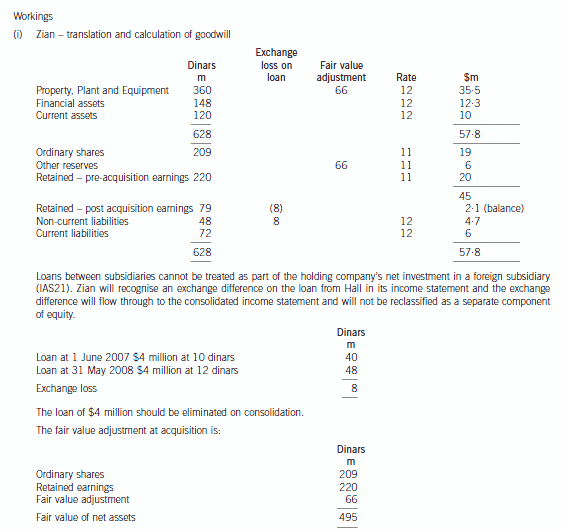


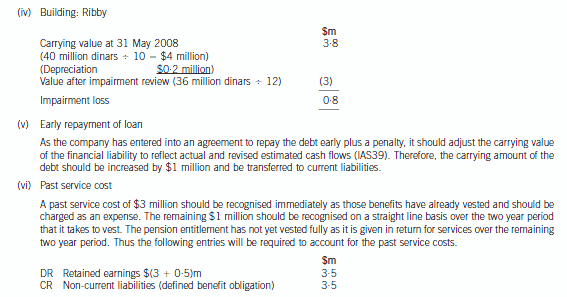
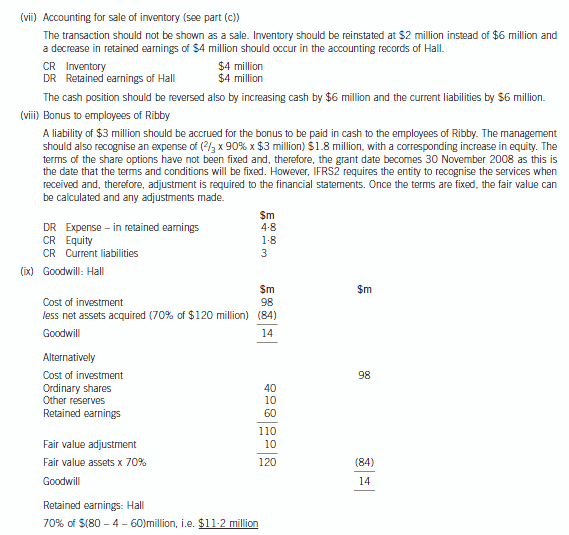
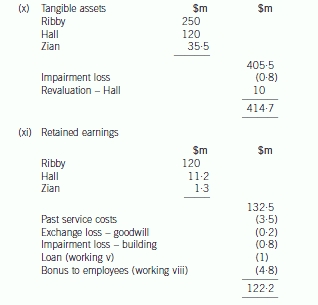

(ii) Advise Clifford of the capital gains tax implications of the alternative of selling the Oxford house and
garden by means of two separate disposals as proposed. Calculations are not required for this part of
the question. (3 marks)
(ii) The implications of selling the Oxford house and garden in two separate disposals
The additional sales proceeds would result in an increase in Clifford’s capital gains and consequently his tax liability.
When computing the gain on the sale of the house together with a small part of the garden, the allowable cost would
be a proportion of the original cost. That proportion would be A/A + B where A is the value of the house and garden
that has been sold and B is the value of the part of the garden that has been retained. Principal private residence relief
and taper relief would be available in the same way as that set out in (i) above.
When computing the gain on the sale of the remainder of the garden, the cost would be the original cost of the property
less the amount used in computing the gain on the earlier disposal. Principal private residence relief would not be
available as the land sold is not a dwelling house or part of one.
(ii) Determine whether your decision in (b)(i) would change if you were to use the Maximin and Minimax
regret decision criteria. Your answer should be supported by relevant workings. (6 marks)
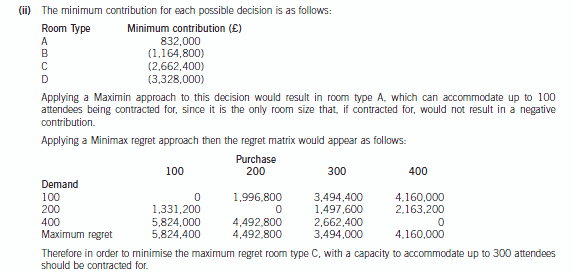
声明:本文内容由互联网用户自发贡献自行上传,本网站不拥有所有权,未作人工编辑处理,也不承担相关法律责任。如果您发现有涉嫌版权的内容,欢迎发送邮件至:contact@51tk.com 进行举报,并提供相关证据,工作人员会在5个工作日内联系你,一经查实,本站将立刻删除涉嫌侵权内容。
- 2020-01-10
- 2020-01-10
- 2020-01-09
- 2020-05-09
- 2020-01-10
- 2020-01-10
- 2020-01-10
- 2020-01-10
- 2020-03-31
- 2020-05-06
- 2020-01-10
- 2020-01-10
- 2020-04-23
- 2020-01-10
- 2020-04-19
- 2020-03-18
- 2020-02-20
- 2020-02-10
- 2020-05-16
- 2020-01-10
- 2020-01-10
- 2020-03-11
- 2020-04-09
- 2020-03-13
- 2019-07-20
- 2020-01-10
- 2021-05-08
- 2020-01-10
- 2020-01-10
- 2020-04-15